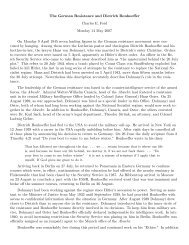Dietrich Bonhoeffer a discussion of the film Bonhoeffer: Agent of ...
Dietrich Bonhoeffer a discussion of the film Bonhoeffer: Agent of ...
Dietrich Bonhoeffer a discussion of the film Bonhoeffer: Agent of ...
You also want an ePaper? Increase the reach of your titles
YUMPU automatically turns print PDFs into web optimized ePapers that Google loves.
as his subsequent martyrdom are seriously undermined by this <strong>film</strong>. His identity as a Christian<br />
<strong>the</strong>ologian is obscured by <strong>the</strong> <strong>film</strong> in a variety <strong>of</strong> ways. Here are two examples. The <strong>film</strong><br />
makes Gandhi <strong>the</strong> subject <strong>of</strong> <strong>the</strong> only seminary lecture by <strong>Bonhoeffer</strong> that it portrays. It draws<br />
on some tentative and incomplete formulations about a “nonreligious language” for Christianity<br />
for <strong>the</strong> only scene resembling a sermon by <strong>Bonhoeffer</strong> that it portrays. Little <strong>of</strong> <strong>Bonhoeffer</strong>’s<br />
Christian <strong>the</strong>ology comes through in <strong>the</strong> <strong>film</strong>.<br />
More seriously, <strong>the</strong> <strong>film</strong> almost completely undermines <strong>the</strong> role <strong>of</strong> <strong>Bonhoeffer</strong> in <strong>the</strong> resistance.<br />
It portrays him as uninformed about <strong>the</strong> realities <strong>of</strong> both <strong>the</strong> Nazi regime and resistance<br />
and, at best, indecisive toward <strong>the</strong> latter. Time and again, <strong>the</strong> <strong>film</strong> portrays <strong>Bonhoeffer</strong> being<br />
shocked and dismayed by resistance activities, not wanting even to be told about <strong>the</strong>m. In fact,<br />
<strong>Bonhoeffer</strong> knew all about things <strong>of</strong> which he is portrayed as ignorant and approved <strong>of</strong> things <strong>of</strong><br />
which he is portrayed as not wanting even to be told. Indeed, <strong>the</strong> importance <strong>of</strong> <strong>Bonhoeffer</strong> to<br />
<strong>the</strong> resistance was his ability to help <strong>the</strong>m make precisely <strong>the</strong> decisions which <strong>the</strong> <strong>film</strong> portrays<br />
as so shocking to him. As portrayed in <strong>the</strong> <strong>film</strong>, it is because <strong>of</strong> his Christianity that <strong>Bonhoeffer</strong><br />
is out <strong>of</strong> touch with and shocked by <strong>the</strong> activities <strong>of</strong> <strong>the</strong> resistance, whereas, in reality, it was<br />
his understanding <strong>of</strong> <strong>the</strong> “this-worldliness” <strong>of</strong> Christianity that made him so important to <strong>the</strong><br />
resistance.<br />
Film <strong>the</strong>mes<br />
The <strong>film</strong> focuses particularly on <strong>the</strong> involvement <strong>of</strong> <strong>Bonhoeffer</strong> family members in <strong>the</strong> resistance.<br />
This is, indeed, one <strong>of</strong> <strong>the</strong> most remarkable families <strong>of</strong> <strong>the</strong> twentieth century. The parents,<br />
Karl and Paula <strong>Bonhoeffer</strong>, had eight children. The second oldest, Walter, was killed in <strong>the</strong><br />
First World War. Of <strong>the</strong> remaining seven all except <strong>Dietrich</strong> were married. Two <strong>of</strong> <strong>the</strong> sons and<br />
two <strong>of</strong> <strong>the</strong> sons-in-law were executed in April 1945. All four executions are portrayed in <strong>the</strong> <strong>film</strong>.<br />
In addition to <strong>the</strong> parents, <strong>the</strong> <strong>film</strong> includes five <strong>of</strong> <strong>the</strong> surviving children, all except <strong>the</strong><br />
oldest and <strong>the</strong> youngest, listed here in descending order <strong>of</strong> age: Klaus, Ursula and her husband<br />
Rüdiger Schleicher, Christine (Christel) and her husband Hans von Dohnanyi, <strong>Dietrich</strong> and his<br />
fiancee Maria, and Sabine (<strong>Dietrich</strong>’s twin) and her husband Gerhard Leibholz. Also portrayed<br />
are a granddaughter, Renate Schleicher, and her husband Eberhard Bethge. The leading resistance<br />
figure, as is portrayed in <strong>the</strong> <strong>film</strong>, is <strong>Dietrich</strong>’s bro<strong>the</strong>r-in-law, Hans von Dohnanyi.<br />
In addition to specific members <strong>of</strong> <strong>the</strong> <strong>Bonhoeffer</strong> family, <strong>the</strong> <strong>film</strong> accurately includes some<br />
<strong>of</strong> <strong>the</strong> central figures and most important activities <strong>of</strong> <strong>the</strong> resistance. Aside from some excellent<br />
documentaries, I can think <strong>of</strong> no <strong>film</strong> that portrays activities <strong>of</strong> <strong>the</strong> German resistance as carefully<br />
as does this <strong>film</strong>. This aspect alone makes <strong>the</strong> <strong>film</strong> worth watching.<br />
Here are some informative features <strong>of</strong> <strong>the</strong> <strong>film</strong>. Participation in <strong>the</strong> resistance involved deception<br />
and raised questions about “telling <strong>the</strong> truth.” The <strong>film</strong> presents some <strong>of</strong> <strong>Bonhoeffer</strong>’s<br />
ideas on this question. The resistance engaged in a rescue action titled “Operation 7.” The <strong>film</strong><br />
<strong>of</strong>fers a coherent, if somewhat overdramatized, presentation <strong>of</strong> it. During <strong>the</strong> interrogation <strong>of</strong><br />
<strong>Bonhoeffer</strong> <strong>the</strong> <strong>film</strong> gives an appropriate portrayal <strong>of</strong> how interrogators attempted to use this<br />
rescue action against <strong>the</strong> resistance. Ruth von Kleist-Retzow, one <strong>of</strong> <strong>the</strong> more exceptional figures<br />
<strong>of</strong> <strong>the</strong> resistance, is portrayed. She could be <strong>the</strong> object <strong>of</strong> an entire <strong>film</strong> herself. The <strong>film</strong> does<br />
not inject scenes <strong>of</strong> Nazi parades, Hitler speeches, concentration camps, or warfare in an attempt<br />
to portray <strong>the</strong> fanaticism and violence <strong>of</strong> <strong>the</strong> period.<br />
Despite <strong>the</strong>se (and o<strong>the</strong>r) strong points, <strong>the</strong> <strong>film</strong> gives a fundamentally flawed portrayal <strong>of</strong><br />
2



